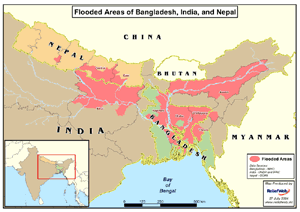|
 Global Analysis / Global Hazards / United States / U.S.
Drought / Extremes
Global Analysis / Global Hazards / United States / U.S.
Drought / Extremes
Use these links toaccess detailed analyses of Global and U.S. data.

 Drought & Heat | Flooding | Storms | Tropical Cyclones | Extratropical Cyclones | Severe Winter Weather
Drought & Heat | Flooding | Storms | Tropical Cyclones | Extratropical Cyclones | Severe Winter Weather


| In the United States, severe to exceptional drought characterized conditions throughout much of the Intermountain West, with the worst-affected areas in parts of eastern Idaho, eastern Wyoming and adjacent areas of Montana. Heavy June and July rains in much of the Southeast U.S. alleviated incipient drought conditions in this region. |
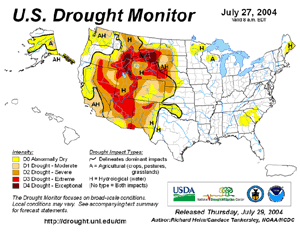
Larger Image
|
For comprehensive drought analysis, please see the current U.S. drought report.
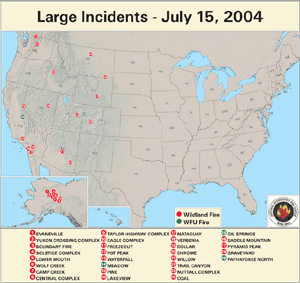 Larger Image Larger Image
|
The long-duration drought throughout much of the western U.S. enhanced wildfire potential, with several large fires scattered across the region during July. Numerous large fires also charred parts of Alaska and the Yukon Territory in Canada. |
For comprehensive analysis on the western and Alaska wildfires, see the 2004 wildfire pages.
| Long term drought continued across areas of Africa, including the Greater Horn and parts of southern Africa (WFP). Above average rainfall was focused across parts of eastern Ethiopia and northern Somalia. |
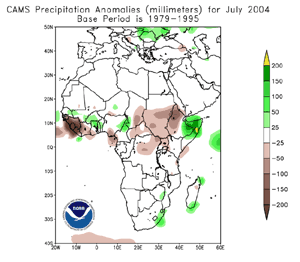 Larger Image Larger Image
|
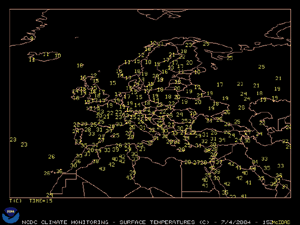 Larger Image Larger Image
|
A heat wave that began in late June 2004 across southern Spain persisted into early July, with maximum temperatures reaching 40°C (104°F) in some locations. Seven fatalities were blamed on the heat since late June (AFP). |
Hot, dry weather that affected the Iberian Peninsula in late June and early July contributed to brush fires across Portugal's southern Algarve region. Several stretches of the Algarve motorway were closed and homes evacuated due to 9 wildfires which affected the area during June 30-July 1. Additional fires continued during the latter half of July, with over 1,300 firefighters involved in combating the blazes (AFP).
In Japan, a heat wave during mid to late July culminated by the 20th with temperatures reaching a record 39.5°C (103°F) in Tokyo's financial district. This was the hottest temperature recorded in the capital since records began in 1923, breaking the previous record of 39.1°C (102°F) set on August 3, 1994. Oppressively hot weather claimed several lives during July in Japan (AFP/Japan Meteorological Agency).


| In India, June flooding associated with the onset of the monsoon season continued during July 2004 in northeastern parts of the country. Border areas of Assam and Arunachal states were struck by flooding on the 5th, submerging dozens of villages and rendering 35,000 homeless. Much of the river flooding originated from upstream in Tibet (BBC News). |
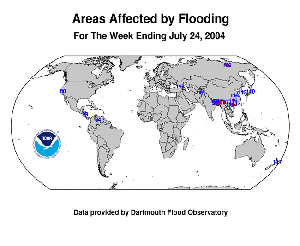 Larger Image Larger Image
|
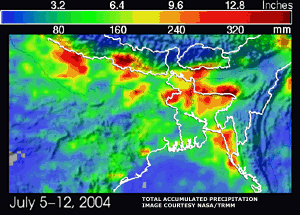 Larger Image Larger Image
|
Across South Asia, millions of residents were displaced by late-month, with the Indian states of Assam and Bihar the worst-affected. Throughout India, Nepal and Bangladesh, more than 1,000 deaths were blamed on flooding brought about by heavy monsoon rains. Flooding in Bangladesh was described as the worst since 1998, with water covering an estimated two-thirds of the country during the height of the flooding (Associated Press/AFP/Reuters). |
Farther to the southeast, heavy rains in northern Vietnam produced flooding that killed 36 people during mid-July 2004. Most of the fatalities occurred in the Ha Giang province (AFP).
In northern Japan, torrential rainfall brought flooding to Niigata prefecture during July 13-14, forcing nearly 20,000 residents into evacuation centers. More than 430 mm (17 inches) of rain fell in some parts of the region, and the resulting floods were blamed for 18 deaths (Reuters/IFRC/Associated Press).
In the United States, strong thunderstorms dumped upwards of a foot of rain on parts of north Texas during the 28th-29th. In southern Dallas county, around 200 homes were damaged by high water in the suburb of Lancaster. One fatality was blamed on the flooding (Associated Press).
| In the U.S. Mid-Atlantic region, strong thunderstorms produced excessive rainfall and severe flooding during the 12th-13th. In central New Jersey, more than 254 mm (10 inches) of rain fell in less than 24 hours. |
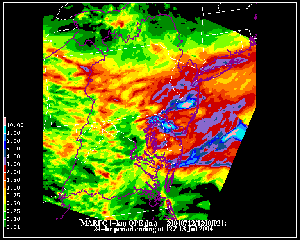 Larger Image Larger Image
|
For an archive of flood events worldwide, see the Dartmouth Flood Observatory.


In eastern China's Anhui province, severe thunderstorms struck Xiao county on the 7th resulting in three deaths and 143 injuries. The storms produced walnut-sized hailstones and strong winds that damaged or destroyed 18,000 homes. Farther west in Sichuan province, a lightning strike on the 4th killed 7 people while injuring 10 others (AFP).
In Canada, severe thunderstorms brought hail and heavy rainfall to parts of Alberta on the 11th, causing damage to crops and businesses. The world's largest shopping mall in Edmonton (West Edmonton Mall) was temporarily closed on the 12th after sustaining damage from flooding and significant accumulations of marble to baseball-sized hail (Reuters).


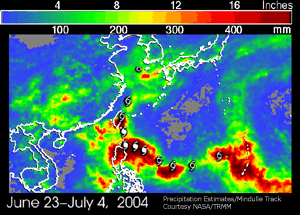 Larger Image Larger Image
|
Typhoon Mindulle developed in June but affected Taiwan and the southeast China coast with torrential rainfall and strong, gusty winds as it trekked northeastward and weakened during July 1-4. Mindulle was blamed for at least 30 deaths in the Philippines, 26 on Taiwan and 2 in China (Associated Press/AFP/NASA). |
| Tropical Storm Kompasu formed in the Philippine Sea on the 13th and passed through the Luzon Strait on the 14th. Kompasu moved inland along the coast of China near Hong Kong by the 16th with maximum sustained winds near 65 km/hr (35 knots or 40 mph). Heavy rains accompanied the storm as it dissipated over Guangdong province. |
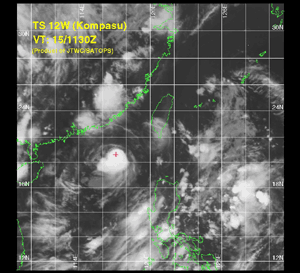 Larger Image Larger Image
|
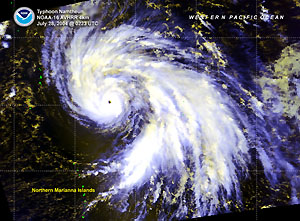 Larger Image Larger Image
|
Typhoon Namtheun developed in the western Pacific Ocean on July 25 and tracked across the island of Shikoku in Japan on the 31st. Namtheun had weakened to tropical storm strength upon landfall, with maximum sustained winds near 100 km/hr (55 knots or 65 mph). The storm also brought locally heavy rainfall to the southern part of Japan. |
A table containing the Accumulated Cyclone Energy (ACE) index for global tropical cyclones occurring during the month of July 2004 is available.


| A powerful storm system lashed the southern and eastern sections of the United Kingdom on the 7th, bringing strong winds and heavy rains. As many as 106,000 homes were affected by blackouts as strong winds cut electrical service to the area (AFP). |
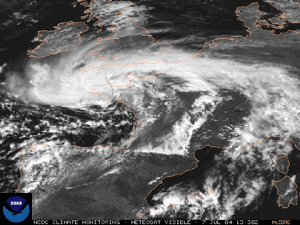 Satellite Animation (4MB) Satellite Animation (4MB)
|


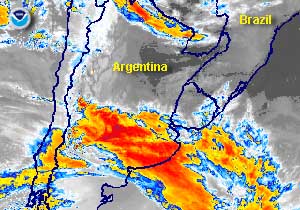 Animation Animation
|
A series of winter storms affected the Patagonia region of Chile and Argentina during late June and into early July 2004. Heavy rains produced mudslides in lower elevations while heavy snow fell across mountainous areas. There were 5 weather-related deaths in Argentina with 4 reported in Chile (AFP). |
| Across Peru, cold weather and heavy snowfall affected parts of the country during late June through mid-July. The cold was blamed for the deaths of 46 children across the country, with cold weather-related illnesses such as pneumonia the primary cause of death. The cold temperatures killed more than 100,000 farm animals throughout the country and destroyed 300,000 hectares (741,000 acres) of crops. (AFP/OCHA). |
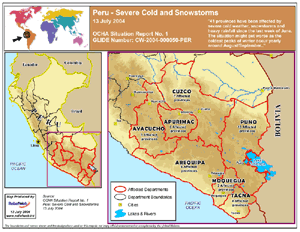 Larger Image Larger Image
|

References:
Basist, A., N.C. Grody, T.C. Peterson and C.N. Williams, 1998: Using the Special Sensor Microwave/Imager to Monitor Land Surface Temperatures, Wetness, and Snow Cover. Journal of Applied Meteorology, 37, 888-911.
Peterson, Thomas C. and Russell S. Vose, 1997: An overview of the Global Historical Climatology Network temperature data base. Bulletin of the American Meteorological Society, 78, 2837-2849.
For all climate questions other than questions concerning this report, please contact the National Climatic Data Center's Climate Services Division:

For further information on the historical climate perspective presented in this report, contact:
Scott Stephens
NOAA/National Climatic Data Center
151 Patton Avenue
Asheville, NC 28801-5001
fax: 828-271-4328
email: Scott.Stephens@noaa.gov

 NCDC / Climate
Monitoring / Climate
of 2004 / Hazards / Search / Help NCDC / Climate
Monitoring / Climate
of 2004 / Hazards / Search / Help
http://www.ncdc.noaa.gov/oa/climate/research/2004/jul/hazards.html
Downloaded Saturday, 20-Sep-2008 11:37:30 EDT
Last Updated Tuesday, 29-Nov-2005 14:04:48 EST by Scott.Stephens@noaa.gov
Please see the NCDC Contact Page if you have questions or comments.
|
















 NCDC / Climate
Monitoring / Climate
of 2004 / Hazards / Search / Help
NCDC / Climate
Monitoring / Climate
of 2004 / Hazards / Search / Help
